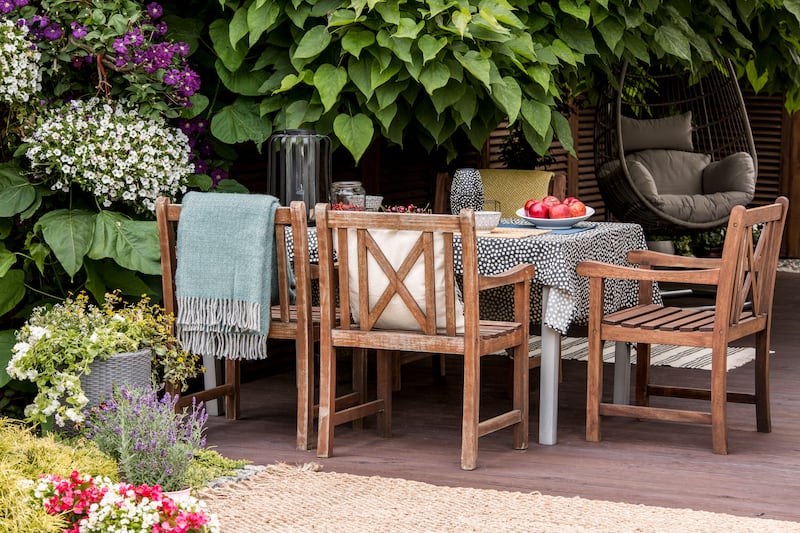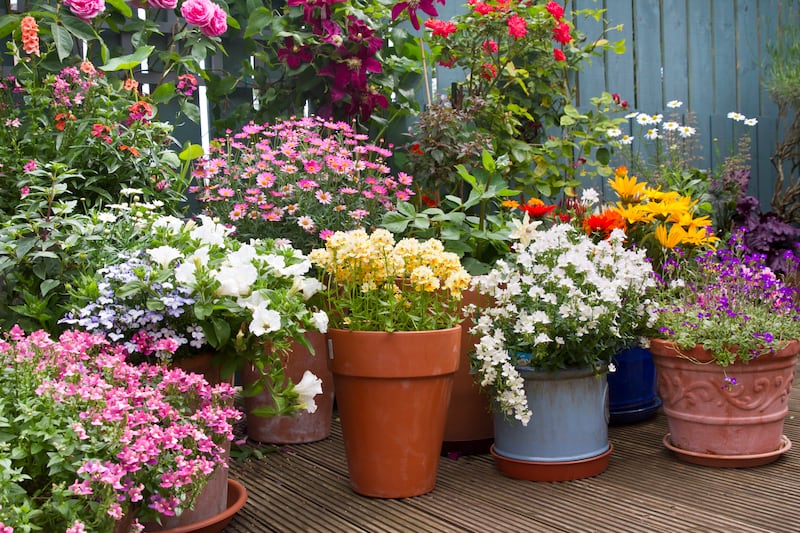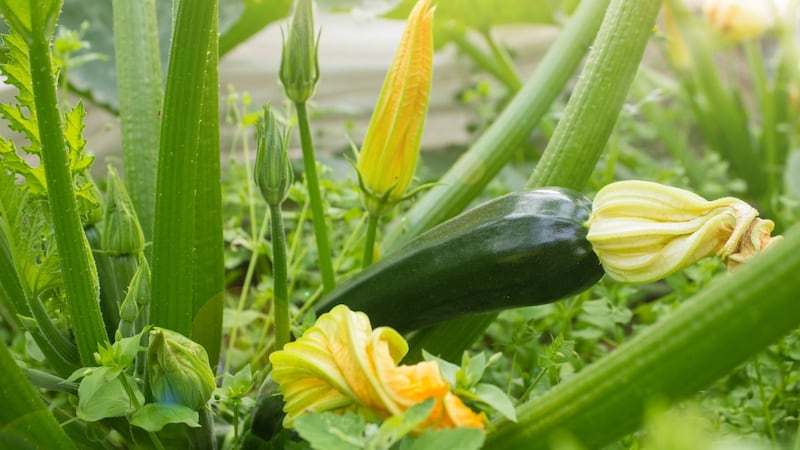Ditch the garden detritus
Nothing makes a garden look and feel sadder and less summery than overgrown beds, tatty, neglected containers filled with half-dead plants, broken or damaged furniture, discarded bags of compost and piles of weeds. Give it a ruthless tidy-up and you’ll instantly change its mood for the better. Brush and wash down paving, vigorously rake pebble paths, and if you’re planning on leaving your lawn uncut as part of the annual No-Mow-May campaign run by Biodiversity Ireland, then mow a winding path through it. Both pretty and practical, it tells the world you care about the way your garden looks as well as its wildlife.
Give sheds, fences, railings a facelift
Once you’re done tidying, take a hard look at any garden sheds, fences, railings – and any structural features such as pergolas – to see if they could do with a bit of a facelift. Could they, for example be given a new lease of life with a fresh coat of paint or woodstain? If so, then check out Little Greene’s sustainable ‘Tom’s Oil Eggshell’ range which is specially formulated to give a durable, washable, long-lasting finish for outdoor use and is suitable for both metalwork and woodwork (see ceramica.ie for further advice). When it comes to choosing a suitable colour, remember that muted, subtle tones always work well in an outdoor space (greys in particular) but be careful when using green to choose a dark, muddy shade that doesn’t look artificial.

Get the furniture right
Bear in mind that garden furniture can make or break the ambience of a garden, especially the use of very chunky, solid, heavy, light-obstructing pieces in small outdoor spaces. If the budget allows, one of the best ways to instantly and dramatically elevate your garden style is by using a classic, graceful, high-quality, long-lasting design that will allow light to flood in and harmonise with the planting. Examples include Fermob’s Airloop and Montmartre collections (available to order from formalityonline.com) and the compact Italian ‘Flower’ collection from Ethimo (howbertandmays.ie).
Go completely potty
No, I don’t mean lose your mind (the world feels quite mad enough as it is). Instead, I’m talking about using a few well-chosen summer containers to quickly create some high octane, pollinator-friendly colour. For properly impressive results, use the biggest, handsomest pots you can afford (see howbertandmays.ie and windyridgegardencentre.ie) and fill them with a high-quality, fresh John Innes based compost (available from all good Irish garden centres), making sure to gently firm it in as you go.
READ MORE

Colourful splash
For maximum visual impact and ease of maintenance, mass plant just one variety/ cultivar into each pot, stick firmly to a colour theme, and cluster your pots together in a sunny, sheltered spot near a doorway or entrance. For example, for a vibrant peachy-orange vibe, you could use Dahlia ‘Totally Tangerine’ (give this hungry beauty a very large pot and work some slow-release fertiliser into the compost to keep it happily flowering into late autumn), in another a peachy-orange foliage plant such as coleus or Heuchera ‘Sweet Tea’ (shade-tolerant, the latter won’t mind being overshadowed by the dahlia), in another the gorgeous half-hardy Cosmos ‘Apricotta’, and in another some salmon-coloured strawflowers (Helichrysum ‘Salmon Rose’,) or surfinias or calibrachoa with flowers in a similar colour.
For cooler, more subtle colour scheme, you could use a white-flowering variety of cosmos such as ‘Purity’, a pale dahlia such as ‘Eveline’, a silver foliage plant such as Senecio ‘Angel Wings or Plectranthus argentatus, a white-flowered variety of calibrachoa and for scent (so important in any garden), some pale-flowered variety of nicotiana. Water well immediately after planting and keep plants irrigated and regularly deadheaded for a display that will go on well into autumn, bearing in mind that any of the half-hardy bedding and annuals listed above need to be protected from the threat of frost until the end of this month.
No-dig vegetable bed
Make an instant, no-dig potager-style bed to provide you with oodles of delicious veg, salad leaves and even some cut-flowers for your home this summer. If you’ve struggled in the past to get anything to grow well in your garden, then this is a sure-fire way to overcome the challenges of poor, compacted soil and weed-infested ground. Ideally choose a bright, open part of the garden or allotment and then start by strimming/scything/cutting back any coarse weedy growth to ground level. Use a garden fork/spade to dig out any woody growth or woody root systems before covering the ground with some overlapping flattened cardboard boxes (hose these down after spreading them out) followed by a 10cm-20cm deep layer of imported topsoil or purpose-made garden compost. Recommended Irish suppliers include mulch.ie and envirogardenandhome.com as well as landscapedepot.ie The cardboard boxes will gradually rot down over several months while simultaneously helping to suppress weeds, allowing you to instantly plant the area with whatever you fancy.
Choose fast-growing plants
For an authentic potager-style look, use a mix of very fast-growing productive plants such as scarlet runner beans grown up willow wigwams for some pretty vertical interest; cut-and-come again salad plants; courgettes; mangetout peas; rainbow chard; dahlias (both beautiful and entirely edible, mrmiddleton.com stocks a great selection of tubers); some pretty, multipurpose English marigolds (properly known as Calendula officinalis, this pollinator-friendly, hardy annual has many uses including in herbal medicine and as a plant dye while its bright orange flowers are also edible) and a few sunflowers (who doesn’t love a jolly sunflower). All of these can be raised from seed sowed in the coming weeks under cover but are also available to buy as young transplants from good garden centres. For a step-by-step guide to the no-dig method, check out the website of the British gardener and no-dig guru Charles Dowding.

Herbs at the ready
Ever calculated how much you’ve spent on fresh herbs over the years, or all too often found yourself silently cursing the fact that your local supermarket has run out of the fresh mint/coriander/basil/parsley/ sage, rosemary/thyme/chervil essential for that favourite recipe? All of these can be grown in pots or window boxes, many of them from seed sowed over the coming weeks, guaranteeing a steady, moneysaving supply of delicious, flavoursome, home-grown, organic herbs for many months to come. Alternatively, if raising your own plants from seed sounds a bit too challenging, then you can always use the potted supermarket herb plants available in the vegetable and fruit aisle, a great way to get your hands on cheap, young plants that can then be potted up. Just make sure to harden them off by gradually accustoming them to cooler, more variable growing conditions.




















